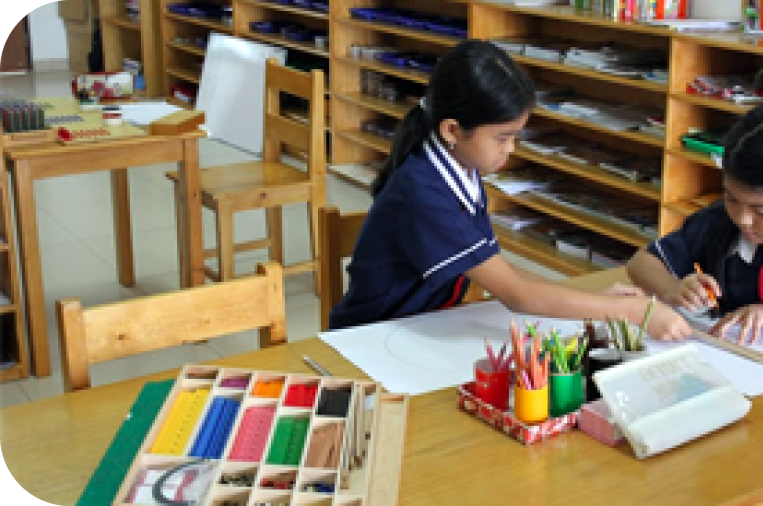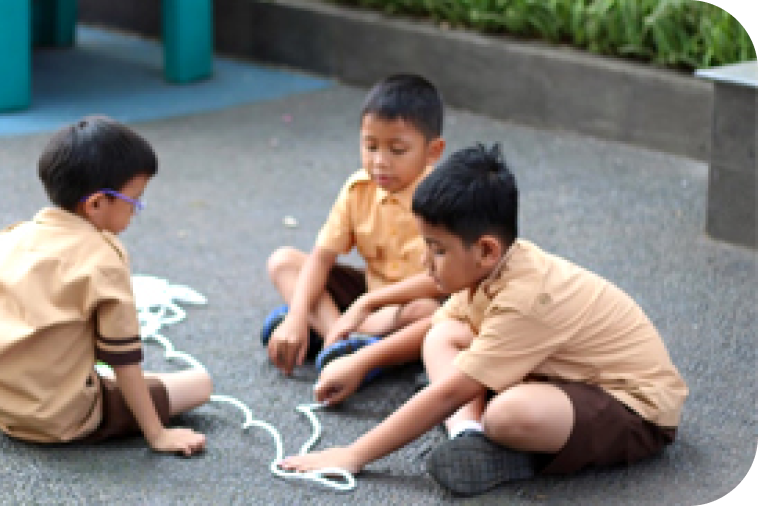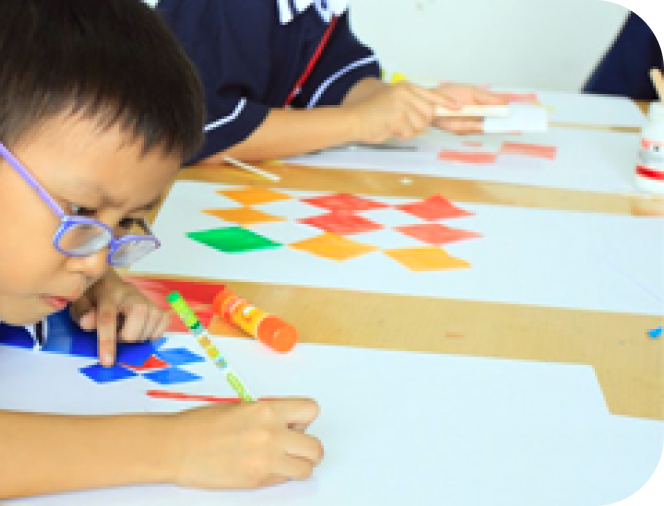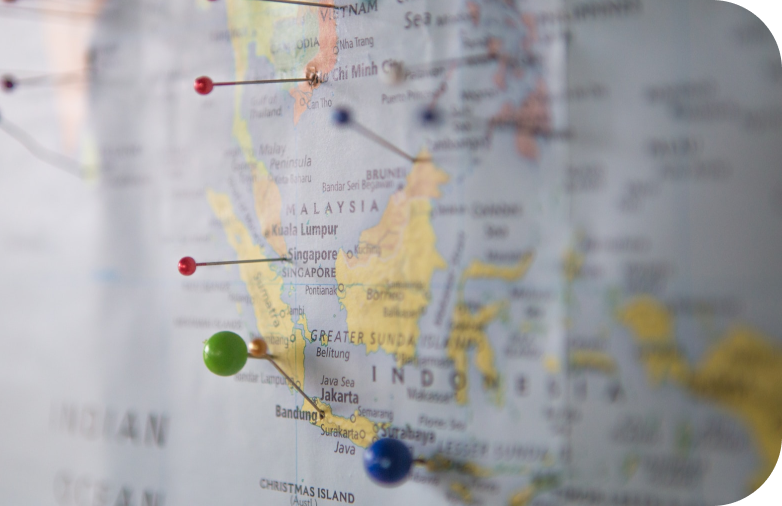
Language Art
Ages 6-9 Lower Elementary and Age 9-12 Upper Elementary
From infancy, children have learned the names of things. In the lower elementary Montessori classroom, students begin to analyze more abstract concepts of language: the how, the why, and the from where? Montessori elementary students explore the history of language, written language, spoken language, literature and grammar, and syntax.
The Montessori Fourth Great Lesson is the story of how writing began. This impressionistic story grabs the attention of young students who are eager to learn about those who came before us. From there, they listen to and read great literature and are further motivated to tell their own stories through creative writing, reports, drama, poetry, and song. Throughout this work, Montessori students are introduced to the rules of human communication through word studies, work with the Montessori Grammar Boxes, as well as beginning logical sentence analysis.

Science
Ages 6-9 Lower Elementary
The lower elementary aged child enters what Montessori called the age of the “reasoning mind”. They now ask questions which begin with “How” and “What if…?” They move beyond themselves and the need to learn names and parts and are able to think more abstractly and see what may be. It is now, where Montessori’s idea of Cosmic Education is presented through the telling of The Five Great Lessons. These imaginative stories provide the framework whereupon the secrets of the universe are presented in the Montessori classroom. Exploration of these concepts is then reinforced by the use of experiments and Montessori impressionistic charts. This is the beginning of the development of scientific thought. Montessori students’ questions become their hypothesis and through the power of observation, they come to their own conclusions about the laws of the universe.
Children in the lower elementary Montessori classroom are introduced to a wide array of scientific principals:
Classification of living and non living things, including Linnaean classification of plants and animals.

Zoology
- The difference between plants and animals
- Identifying and classifying animals
- Identifying parts of insects, arachnids, crustaceans, mollusks, fish, amphibians, reptiles, birds, and mammals
- Basic needs of animals
Botany
- Basic needs of plants
- Parts of Herbaceous Plants
- Parts of Trees & Shrubs
- Identification of roots, stems, leaves, seeds, fruit
Health Sciences
- Self esteem
- Systems of the human body
- Nutrition
- Physical Education
Microscopic Study
- Atoms & Molecules
- The Periodic Table of Elements
- States of Matter
- Elements, Compounds and Mixtures
This system in which a child is constantly moving objects with his hands and actively exercising his senses, also takes into account a child's special aptitude for mathematics. When they leave the material, the children very easily reach the point where they wish to write out the operation. They thus carry out an abstract mental operation and acquire a kind of natural and spontaneous inclination for mental calculations. ~The Discovery of the Child, Maria Montessori.
The Montessori math materials are perhaps some of the most inviting and beautiful works in our Montessori classroom. Visitors to our Montessori classroom, young and old alike, gravitate to the math shelves, wanting touch and learn how to use the materials. “Show me this. How does this work?” they ask. Adults usually sigh and wistfully say, “I wish I had learned math this way”.

Science
Ages 9-12 Upper Elementary
Still directly tied to the Five Great Lessons, the Montessori upper elementary science curriculum is about the further development of the scientific method. Children now have the ability to focus on in-depth research. They are able to actively engage with what interests them by conducting experiments based on scientifically formulated hypotheses, collecting and interpreting data, and presenting their results. This is a time when Montessori classroom or school science fairs can be used to encourage scientific exploration, research, and promote the sharing of ideas with others.
Scientific inquiry in the Montessori upper elementary classroom encompasses:

Zoology
- Animal routines
- Animal sounds
- Advanced classification
- Basic needs of animals
- Organ systems
- Reproduction
- Adaptations
- Rehabilitation
Botany
- Root systems & functions
- Photosynthesis and transpiration
- Plant vascular system and function
- Pollination
- Identifying common flowers, trees, shrubs
- Using a field guide
Health Sciences
- Systems of the human body
- Microorganisms and hand washing
- Safe food handling
- Nutrition
- Personal hygiene
- Internet safety
- Human life cycle
Microscopic Study
- Cell structure of plant and animal cells
- Food spoilage and preservation
Organic Matter
- Atomic structure
- Advanced study of states of matter
- Acids & bases
- Water density
- Chemical formulas
Scientific Method
- Using a microscope
- Gathering data
- Using the scientific method for experiments
- Using a triple-beam scale
Technology
- Roman arches
- Internet citizenship
- Globalization
- Simple machines
- Responsible technology usage
- Computer classes
Mathematics
Ages 0-6 Lower Elementary
The lower elementary Montessori classroom is full of ongoing discoveries. Spurred on by the telling of the fifth Great Lesson, “The History of Mathematics”, children are motivated to learn about their own number system and uncover the mysteries as did those who came before.
The absorbent mind of early childhood has given way to a reasoning mind which enjoys learning about natural truths and laws of nature. The mathematical facts learned in the Montessori Children’s House are now tested to see if there are rules and laws to be discovered and manipulated. Patterns are sought as the child seeks to discover the empirical truths of the universe through the use of the concrete Montessori math materials. It is now that children are able to use their imaginations to see beyond the immediate.
They are able to see beyond the concrete representations and imagine higher place values within the decimal system. Montessori lower elementary age children are much more social beings than they were in the Preschool class. They enjoy working collaboratively and sharing their discoveries with each other. After all, the laws of the universe are too incredible not to share!

Mathematics
Ages 6-9 Upper Elementary
The inquisitiveness of the upper elementary Montessori student is astounding. The beauty of the advanced squaring and cubing materials beckons like beacons, inviting the students to come explore and learn with them. They dive into the study of fractions and decimals, eager to move beyond to more complex mathematics, geometry, and algebra. While the concrete materials are still in place, the need for repetition is gone. “Show me. Then, show me more” is the litany of the upper elementary Montessori math students. Upper elementary students move quickly from the concrete experience to abstract thought. They are eager to test their knowledge with pencil and paper and need, at times, a gentle reminder to return to the materials as a way of building neurological pathways.

Geography
Ages 6-9 Upper Elementary
The Montessori Great Lessons are a series of imaginative and impressionistic lessons which serve to spur the imagination and creativity of young children, encouraging them to explore the vast world around them. The First Great Lesson recreates the origins of the universe and the creation of our home planet, Earth. This story, told in language that is easily understood, gives just enough information to create an interest in finding out more. This focus on physical geography is the foundation for much the Montessori lower elementary cultural curriculum which focuses on the creation of the earth, the nature of the elements, the relationship of the sun and earth and the work of air and water.
Montessori lower elementary students also learn about human society and community. Children “go out” into the world to experience and acquire culture through personal experience. Montessori believed that the world had the ability to serve as the child’s classroom and that real-life experience superseded what could be taught using materials and books.
